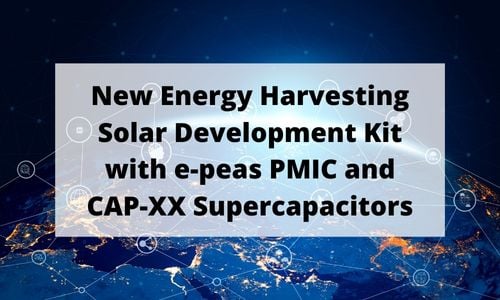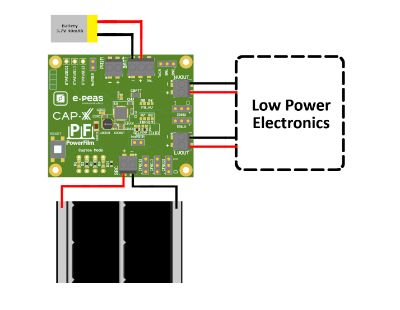Posted on 11/01/2022 at 10:00 by
Seth Hansen

Originally published 9-8-2020
An effective solar energy harvesting solution requires more than just a solar panel.
We have partnered with e-peas, an energy harvesting PMIC solution provider, and thin prismatic supercapacitor manufacturer, CAP-XX, to launch our new solar development kit.
Watch this free on-demand webinar to hear from the development kit’s creators and learn more about how each company can help you design a perpetual IoT edge device.
Download this blog post to take with you!
With the e-peas AEM10941 PMIC, our newest compact thin-film flexible solar panels, and two CAP-XX models of supercapacitors, the kit delivers industry-leading performance and a platform for developers to design, test, and prototype solar energy harvesting solutions for low-power Internet of Things (IoT) devices and remote electronics.
Solar Energy Harvesting Development Kit Layout

The Solar Development Kit with e-peas PMIC and CAP-XX Supercapacitors (DEV-EPEAS-CAPXX) makes integrating solar into electronics simple. It includes an e-peas AEM10941 high-performance energy harvesting PMIC, PowerFilm’s thin-film indoor and outdoor solar panels, and CAP-XX thin prismatic supercapacitors.
The AEM10941 efficiently extracts energy from the solar modules, which can be stored in a rechargeable element, or supercapacitor, while providing two independent regulated voltages to power IoT devices.
The integrated power management supports multiple storage element charge configurations, including, Li-Po, Li-ion, LiFePO4, Solid State, and single/double cell supercapacitors.
Configurations are easily selected by moving pin jumpers to desired positions.
This dev kit is an ideal power source for any low-power electronic device, especially in emerging IoT applications such as BLE beacons, trackers, sensors, ESLs, RTLS, telematics, wearables, smart locks, thermostats, livestock monitoring, and industrial automation.
Differentiating Features
Energy Harvesting PMIC
- Industry-leading boost converter efficiency (95%) with ultra-low global leakage (400nA).
- Lowest cold start power and voltage available (3uW at 50mV).
- Small PCB footprint with only seven passives.
- Dual cell supercapacitor cell balancing circuit and landing pads.
- Dual low and high voltage power output rails.
- Primary battery backup option.
- Custom charge profile options.
Thin-Film Flexible Solar Panels
- Smaller size/form factor to better serve compact, ultra-low power devices.
- New higher-performance "fingerless" indoor material with reduced interconnect shadowing.
- Ultra-thin, flexible, and highly durable.
- Custom sizes, options, and configurations are available based on application requirements.
CAP-XX Supercapacitors
- DMT3N4R2U224M3DTA0 4.2V, 220mF, 21 x 14 x 2.2 mm, -40 to 85°C, ESR 300mΩ
- DMF3Z5R5H474M3DTA0 5.5V, 470mF, 21 x 14 x 3.2 mm, -40 to 70°C, ESR 45mΩ
- High power output for peak current loads (low ESR)
- Sufficient energy storage to handle power surges (high capacitance)
- Wide operating temperature range (-40°C – +85°C)
With high-performance thin-film solar panels, industry-leading energy harvesting PMIC, and the thinnest prismatic supercapacitors on the market, this kit is the perfect platform for developing a solar energy harvesting solution for low-power electronics and IoT devices in indoor and outdoor settings.
With the right tools, anyone can use solar energy harvesting to enable innovative, perpetual IoT devices that are not limited by a finite power source.
PowerFilm and e-peas offer the expertise needed to help you develop a solar energy harvesting solution.
Contact us to learn more about solar energy harvesting for your devices and specific applications.
Download this blog post to take with you!